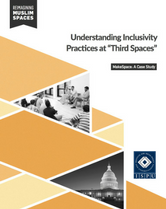
Understanding Inclusivity Practices at “Third Spaces” | MakeSpace: A Case Study
This fourth report in ISPU’s “Reimagining Muslim Spaces” series presents a case study of MakeSpace, an example of the recent Third Space phenomenon. Using MakeSpace as a case study, we examine how a Third Space is different from a traditional American mosque and what attracts participants to Third Spaces. Specifically, we examine how Third Spaces establish inclusivity practices that are considered to be an improvement on traditional mosques. In studying inclusivity practices, we focus on three key demographics: women, youth, and converts/ new Muslims.
The goal of the 'Reimagining Muslim Spaces' project is to produce research-driven recommendations to enable the development of a mosque that is:
- Welcoming: Inclusive and engaging
- Well Governed: Effective and transparent
- A Hub for Hope: A source of community service
To illustrate how mosques can serve as hubs for hope, ISPU identified real life examples of American Muslim Institutions doing just that. Rather than simply providing theoretical advice, our researchers interviewed the very people who built these programs and institutions to identify the secret to their success and the wisdom gained from their struggles. We hope these case studies will inspire and instruct others working to develop institutions that serve and uplift.
Insert your information to download the case study.
ISPU uses this information to see which organizations and individuals are using our materials in an effort to better serve our audiences. We’ll also contact you (infrequently) with new research updates so you’re up to date on the latest from our research team.


